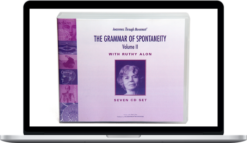Tias Little – Traditions of Meditation – Collection
$149.00 $33.00
»Delivery: Within 24hs
Description
Tias Little – Traditions of Meditation – Collection
Description Of Traditions of Meditation
Meditation is integral to the experience of yoga and we might ask ourselves the question, if meditation is not included in a sadhana (practice), is it really yoga? This course explores the historical roots of how and why meditation became central to yoga. We explore the powerful notion within yoga that everything is “mind made”. By way of suspending sensory awareness, building concentration, insight and absorption, the yogi is freed from anguish, anxiety and suffering.
We will emphasize how meditative awareness is anchored in the body and how meditation is like a sword that cuts through the cobwebs of delusional thinking. We will see how yoga is essentially a practice of realization by seeing into the nature of mind. Each module includes take home meditation practices.
What You’ll Learn In Traditions Of Meditation
Module 1: The Root of the Mind
There is evidence in early Indian, Greek and Persian cultures that physicians and spiritual alchemists established concentration practices in order to cultivate luminous states of meditation. In this module, we explore the early references to meditation within the Vedas and use selections from the Mandukya Upanisad to map fours states of consciousness– waking, dream, sleep and “sivam” the state of tranquility.
Module 2: Yoga and Samadhi
In this week we will see how verses from the Bhagavad Gita and sutras from Patanjali’s Ashtanga Yoga underscore meditation as a gateway to yoga liberation. We investigate the “inner limbs” within Patanjali’s Yoga Sutras –pratyhara, dharana, dhyana and samadhi—as a means to “stopping” the mind.
Module 3: The Subtle Body
In hatha yoga there are innumerable channels that conduct the flow of prana and neurological hubs along the spine that are storehouses of psychic and somatic power. This session explores the pathways of the subtle body including breath, blood, nerve and spinal shaft as means to cultivate meditative awareness and how yogic power comes about via amplification of the vital essence.
Module 4: Siddhartha’s Vision
In this module we explore the insights of the wandering sage who became the Buddha. Rooted in meditation and mindfulness, the Buddha’s awakening gave birth to numerous schools of meditation. We explore the foundation of mindfulness and see how all things are transient, inter-dependent and not “me”.
Students who take this course will:
- Explore the link of the senses to the mind, and see that sensory stimuli can either be an obstacle or support to meditation
- Read verses from the Upanisad that map the mind in three states: waking, sleep and dream
- Practice using the body as a means to harness meditative awareness
- Gain insight into yoga meditation as process of reflection, attention and discernment
- Study the Eightfold Path of the Buddha’s teaching
- Practice Vipassana Meditation and Shamatha (calm abiding)
- Explore the Four Foundations of Mindfulness within the early Buddhist teaching
- See how in Mahayana Buddhism the very nature of the mind is empty
About Tias Little
Tias Little synthesizes more than 30 years of study in classical yoga, Sanskrit, Buddhism, anatomy, and trauma healing in his dynamic, original style of teaching. Tias was an English major at Amherst College and earned a Master’s degree in Eastern Philosophy from St. John’s College in Santa Fe in 1998. Tias co-directs Prajna Yoga, an internationally-acclaimed yoga school located in Santa Fe, New Mexico with his wife Surya. He is the author of three books: Meditations on a Dewdrop, Yoga of the Subtle Body, and Practice is the Path: Lessons and Reflections on the Transformative Power of Yoga.
More courses from the same author: Tias Little
Delivery Policy
When will I receive my course?
You will receive a link to download your course immediately or within 1 to 21 days. It depends on the product you buy, so please read the short description of the product carefully before making a purchase.
How is my course delivered?
We share courses through Google Drive, so once your order is complete, you'll receive an invitation to view the course in your email.
To avoid any delay in delivery, please provide a Google mail and enter your email address correctly in the Checkout Page.
In case you submit a wrong email address, please contact us to resend the course to the correct email.
How do I check status of my order?
Please log in to HealingCourse account then go to Order Page. You will find all your orders includes number, date, status and total price.
If the status is Processing: Your course is being uploaded. Please be patient and wait for us to complete your order. If your order has multiple courses and one of them has not been updated with the download link, the status of the order is also Processing.
If the status is Completed: Your course is ready for immediate download. Click "VIEW" to view details and download the course.
Where can I find my course?
Once your order is complete, a link to download the course will automatically be sent to your email.
You can also get the download link by logging into your HealingCourse account then going to Downloads Page.
Related products
Total sold: 1








